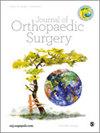Imaging evaluation of extraarticular posterior loose bodies in varus ankle osteoarthritis
IF 1.6
4区 医学
引用次数: 0
Abstract
Purpose: Multiple loose bodies (LBs) are often found in patients with varus ankle osteoarthritis (OA). This study aimed to investigate the characteristics of extra-articular posterior ankle LBs in patients with varus ankle OA. We also sought to determine whether there were variations in the characteristics of LBs according to the degree of ankle OA. Methods: We retrospectively reviewed 50 patients who had appeared posterior extraarticular LBs on preoperative ankle imaging among the patients who underwent operative treatment for varus ankle OA from March 2011 to February 2023. We categorized the entire patient cohort into four groups according to the degree of ankle arthritis (Takakura stage II, IIIA, IIIB, and IV). Size, number, and location of LBs were evaluated using preoperative computed tomography and magnetic resonance imaging. Results: 142 LBs were identified (mean size: 11.5 mm); 76.8% were located within the flexor hallucis longus (FHL) tendon sheath, 20.4% in the posterior recess, and 2.8% in the flexor digitorum longus tendon sheath. Average LB size was significantly larger in Takakura stage IIIB and IV patients ( p < .05), and the LB number was significantly lower in stage II patients ( p = .013). Conclusion: Extra-articular posterior LBs in varus ankle OA are predominantly located within the FHL tendon sheath and were larger in Takakura stages IIIB and IV patients.Level of Evidence: Level III. Retrospective comparative study.曲踝骨关节炎患者关节外后松动体的影像学评估
目的:在踝关节屈曲性骨关节炎(OA)患者中经常会发现多个松动体(LBs)。本研究旨在调查踝关节OA曲张患者关节外后踝松动体的特征。我们还试图确定 LBs 的特征是否随踝关节 OA 的程度而变化。研究方法我们回顾性研究了 2011 年 3 月至 2023 年 2 月期间因踝关节 OA 屈曲接受手术治疗的患者中,术前踝关节成像显示出现后方关节外 LB 的 50 名患者。我们根据踝关节炎的程度(高仓健 II 期、IIIA 期、IIIB 期和 IV 期)将所有患者分为四组。术前使用计算机断层扫描和磁共振成像对枸橼酸钙的大小、数量和位置进行了评估。结果共发现 142 个 LB(平均大小:11.5 毫米);76.8% 位于拇长屈肌腱鞘内,20.4% 位于后凹处,2.8% 位于拇长屈肌腱鞘内。高仓IIIB期和IV期患者的平均枸橼酸瘤大小明显增大(p <.05),II期患者的枸橼酸瘤数量明显减少(p = .013)。结论外翻性踝关节 OA 的关节外后 LB 主要位于 FHL 腱鞘内,在高仓 IIIB 期和 IV 期患者中更大:证据等级:III级。回顾性比较研究。
本文章由计算机程序翻译,如有差异,请以英文原文为准。
求助全文
约1分钟内获得全文
求助全文
来源期刊

Journal of Orthopaedic Surgery
Medicine-Surgery
自引率
0.00%
发文量
91
期刊介绍:
Journal of Orthopaedic Surgery is an open access peer-reviewed journal publishing original reviews and research articles on all aspects of orthopaedic surgery. It is the official journal of the Asia Pacific Orthopaedic Association.
The journal welcomes and will publish materials of a diverse nature, from basic science research to clinical trials and surgical techniques. The journal encourages contributions from all parts of the world, but special emphasis is given to research of particular relevance to the Asia Pacific region.
 求助内容:
求助内容: 应助结果提醒方式:
应助结果提醒方式:


